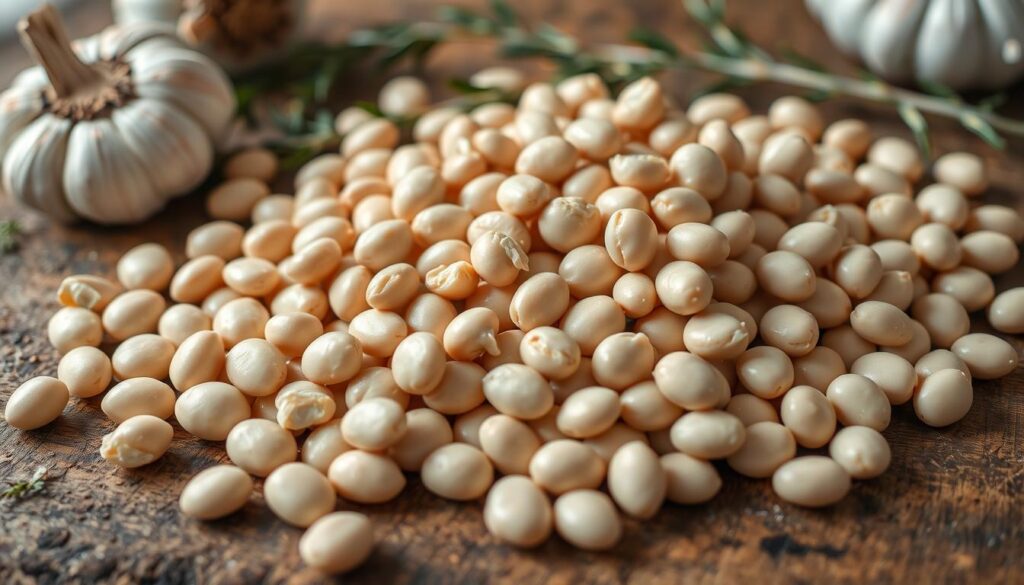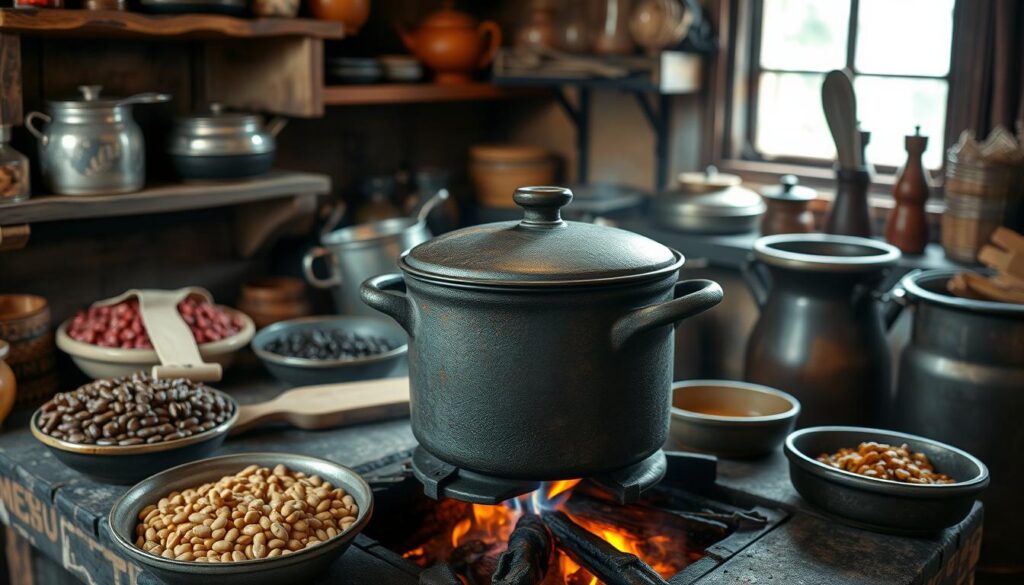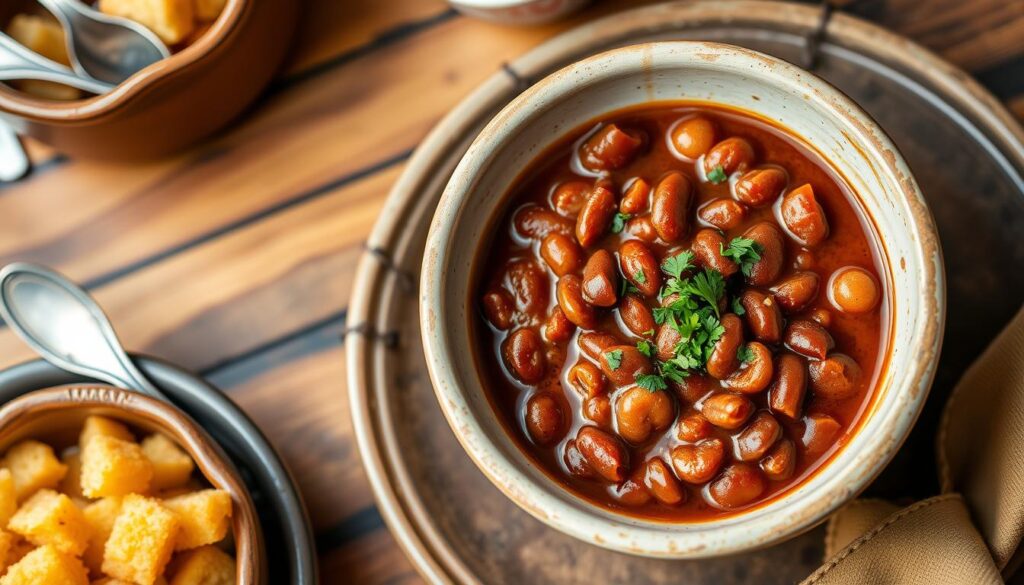Boston baked beans are a classic New England dish. They are slow-cooked with molasses, salt pork, and navy beans. This recipe has a long history, dating back to colonial times. The Boston area was once called “Beantown” because of its love for this dish.
The slow cooking takes 6-8 hours. It makes the beans tender and the sauce thick and sweet. Unlike modern recipes, traditional ones don’t use ketchup or tomato paste. Instead, they use the beans’ natural starch to thicken the sauce. This keeps the flavor pure and unchanged over the years.
- Key Takeaways
- Native American Origins and Colonial Influence
- The Molasses Trade Impact
- Evolution Through the Centuries
- Selecting the Right Cut of Pork
- Modern Substitutes and Alternatives
- Proper Preparation Methods
- Temperature Control and Timing
- Understanding Bean Chemistry
- Balancing Sweet and Savory Flavors
- Sauce Thickening Techniques
- Proper Storage Methods
- Reheating Without Losing Texture
- What are the key ingredients in traditional Boston baked beans?
- What is the role of salt pork in Boston baked beans?
- Why are navy beans the preferred choice for Boston baked beans?
- What is the importance of slow cooking for Boston baked beans?
- How does the traditional cooking method impact the flavor and texture of Boston baked beans?
- What are common mistakes to avoid when making Boston baked beans?
- How should Boston baked beans be served and paired?
- How can Boston baked beans be stored and reheated?
Key Takeaways
- Boston baked beans are a long-standing tradition in New England cuisine, dating back to the time of the Pilgrims.
- The slow cooking process, often taking 6-8 hours, results in tender beans with a thick, flavorful molasses-based sauce.
- Traditional recipes avoid modern additions like ketchup or tomato paste, instead relying on natural bean starch to thicken the sauce.
- The dish’s origins are closely tied to the region’s nickname “Beantown” and the use of molasses, a byproduct of the colonial-era Caribbean trade.
- Mastering the balance of sweet and savory flavors, as well as the proper cooking techniques, are key to achieving authentic Boston baked beans.
The History Behind Boston’s Famous “Beantown” Legacy
The humble molasses beans are a key part of new england cuisine. They have a rich history tied to Boston. This history goes back to the Native American tribes who first lived there. Over time, the dish has changed, showing the many cultures that have influenced it.
Native American Origins and Colonial Influence
Before European settlers arrived, molasses beans were a staple for Native American tribes in the Northeast. They cooked beans in maple syrup, making a dish that was both savory and sweet. This dish is the base of the Boston baked beans we know today.
The Molasses Trade Impact
Molasses, a byproduct of the Atlantic slave trade, changed Boston’s food history. With molasses available, cooks in Boston started using it in their baked bean recipes. This gave Boston baked beans their unique taste, earning Boston the nickname “Beantown.”
Evolution Through the Centuries
The recipe for Boston baked beans has changed over time. It kept its core ingredients but adapted to new tastes and resources. Today, while still loved, baked beans are less popular in Boston. This is because the city’s food scene has grown more diverse and gourmet.
Even with a decline in baked bean popularity, Boston’s “Beantown” nickname remains strong. It shows the lasting impact of this simple dish on Boston’s culture and food heritage. This heritage continues to influence New England’s culinary scene.
| Statistic | Data |
|---|---|
| Few Boston restaurants still serve baked beans | It is challenging to find Bostonians who eat baked beans regularly for Saturday night supper |
| Decline in the popularity of baked beans reflects changing culinary preferences in Boston | Baked beans are not on the menus of Boston’s best new restaurants |
| Boston is home to more than 3,000 restaurants | Twelve Boston-area restaurants and chefs made it into the James Beard Award semifinals in 2023 |
| Market Basket has opened 13 locations across Massachusetts since 2013 | Massachusetts is home to more than 200 breweries |
Essential Ingredients for Authentic Boston Baked Beans
Creating the perfect Boston baked beans starts with quality ingredients. At the core are navy beans, which make the dish creamy and hearty. The recipe also needs a rich, molasses-based sauce for its deep flavor.
Salt pork is another key ingredient, adding pure pork flavor. Some recipes use bacon, but salt pork is traditional for its unique taste.
Brown sugar, onions, and mustard are also essential. Brown sugar, often molasses, balances the flavors with a hint of sweetness. Onions add depth, and mustard brings a gentle heat.
The right mix and quality of these ingredients are crucial. Whether you’re an experienced cook or new to Boston baked beans, knowing each ingredient’s role is key to making it right.
| Ingredient | Amount | Purpose |
|---|---|---|
| Navy Beans | 1 pound | Provides the creamy, hearty foundation |
| Salt Pork | 4 slices (about ¼ pound) | Imparts a pure, unadulterated pork essence |
| Molasses | ⅓ cup | Lends the signature deep, complex flavor |
| Brown Sugar | ⅓ cup | Balances the savory elements and adds sweetness |
| Onion | 1 sweet onion | Provides depth and aromatics |
| Mustard | 1 tablespoon | Adds a gentle heat to complement the other flavors |
By choosing and mixing these key ingredients, you can make authentic Boston baked beans. This dish will take you straight to “Beantown” with every bite.
The Role of Salt Pork in Traditional Recipe
Salt pork is key in traditional Boston baked beans. It gives the dish its unique flavor and texture. This cured pork, from the pig’s back, adds a rich, savory taste that’s essential to the dish’s authentic flavor.
Selecting the Right Cut of Pork
Choosing the right salt pork is important for your baked beans. You can pick from the side, belly, or back of the pork. The fattier the pork, the more flavor it will add to your dish.
Modern Substitutes and Alternatives
While salt pork is traditional, you can also use modern substitutes. Pork belly and thick-cut bacon work well too. Just remember, they might need different cooking times and fat rendering.
Proper Preparation Methods
Preparing salt pork for Boston baked beans is easy. Some types might need a quick rinse to remove excess salt. Others can be used straight from the package. You usually don’t need to precook the salt pork because the beans cook for a long time.
| Pork Cut | Fat Content | Flavor Impact |
|---|---|---|
| Salt Pork | High | Rich, Savory |
| Pork Belly | High | Succulent, Smoky |
| Bacon | Moderate | Smoky, Salty |
Understanding salt pork’s role and exploring alternatives ensures your Boston baked beans taste authentic. This dish is a beloved part of New England’s food heritage.
Navy Beans: The Foundation of Perfect Baked Beans
Navy beans are the go-to choice for traditional Boston baked beans. They are small, creamy white, and keep their shape well during slow cooking. This makes them hearty and satisfying in every bite. Dried navy beans are better than canned for their rich flavor and quality.
Soaking navy beans overnight is key. It cuts cooking time from 10-12 hours to 5-6 hours. The soak also helps the beans cook evenly, making them tender but still firm.
Some recipes suggest par-cooking the navy beans before mixing them with other ingredients. This step keeps the beans from becoming mushy. With proper preparation, navy beans become the base of the famous Boston baked bean dish.

“The Massachusetts Legislature recognized the baked navy bean as the official bean of the commonwealth in 1993.”
For your Boston baked beans, choose high-quality navy or Great Northern beans. These white beans offer the right texture and soak up the molasses-based flavors. This makes the dish a true New England classic.
The Science of Slow Cooking Boston Baked Beans
Slow cooking is key to perfect Boston baked beans. It makes the beans tender and the molasses rich. Knowing the science behind it helps you make the best beans.
Temperature Control and Timing
The best temperature for slow-cooking is 250°F (120°C). This heat, kept steady for 6-8 hours, makes the beans tender. The molasses in the recipe helps by slowing down the softening process.
Understanding Bean Chemistry
The sauce thickens as the beans cook. Their starches release, making the beans creamy. This is what makes Boston baked beans so special.
| Ingredient | Quantity |
|---|---|
| Dry white beans (e.g., Navy or Great Northern) | 1 pound (2 to 2 1/4 cups) |
| Molasses | 1/3 cup |
| Brown sugar | 1/3 cup |
| Dijon mustard | 3 to 4 tablespoons |
| Ground cloves | 1/8 teaspoon |
| Hot water | 3 cups |
| Salt pork (or bacon) | 1/2 pound |
Understanding slow-cooked beans and bean chemistry ensures perfect homemade Boston baked beans.
Traditional Cooking Methods and Equipment
Preparing the perfect Boston baked beans requires the right cooking methods and equipment. Historically, people used clay bean pots or cast-iron Dutch ovens. These were chosen for their heat retention, ensuring the beans cooked evenly and slowly.
In the past, beans were cooked in masonry ovens or buried in the ground. This method gave them a smoky flavor. Today, while slow cookers are convenient, the traditional oven method is still the best for flavor and texture.
- Clay bean pots or cast-iron Dutch ovens are the traditional cooking vessels of choice for Boston baked beans, as they distribute heat evenly and allow for slow, gentle cooking.
- Historically, beans were cooked in masonry ovens or buried in ember-filled holes in the ground, imparting a smoky, earthy flavor.
- While slow cookers offer a convenient option, the traditional oven method, despite its longer cooking time, is still considered the superior way to achieve the perfect Boston baked beans.

The secret to great Boston baked beans is using the right cooking equipment. By sticking to traditional methods and vessels, home cooks can make a dish that truly captures the essence of this New England classic.
Mastering the Molasses-Based Sauce
The molasses-based sauce is the heart of Boston baked beans. It’s a mix of sweet and savory flavors. This comes from molasses, brown sugar, mustard, and salt.
Balancing Sweet and Savory Flavors
To make a true Boston baked bean sauce, balance is key. Use molasses and brown sugar for sweetness. Add mustard and salt for savory taste. Don’t overdo it with ketchup or tomato paste, as they can mask the flavor.
Sauce Thickening Techniques
As beans cook, they release starches, thickening the sauce. If it’s too thin, a cornstarch slurry can help. But be careful not to make it too thick or heavy.
| Ingredient | Amount |
|---|---|
| Molasses (not blackstrap) | 1/3 cup |
| Light or Dark Brown Sugar | 1/4 cup, packed |
| Dijon Mustard | 1 tablespoon |
| Apple Cider Vinegar | 1 tablespoon |
| Kosher Salt (optional) | 1 teaspoon |
Mastering the molasses-based sauce brings out the best in Boston baked beans. It makes the dish comforting and full of flavor.
Common Mistakes to Avoid When Making Baked Beans
Making the perfect batch of baked beans takes patience and focus. Stay away from these common mistakes to make sure your baked bean recipes are always a hit:
- Not soaking the beans properly: Some debate the need for soaking, but it can make cooking faster and beans softer. Soak them in cold water for 4 to 24 hours or use a quick-soak method.
- Cooking at too high a temperature: Baked beans need to cook slowly to get the right texture and taste. Cooking too fast can make them mushy.
- Using too much salt pork: Salt pork is a classic ingredient, but too much can make the beans greasy and salty. Follow the recommended amounts in your cooking tips.
- Not cooking them long enough: Baked beans need several hours to develop their rich flavors. Don’t rush the cooking time.
- Choosing canned beans over dried: While canned beans are easy, they often lack the texture of dried beans. Dried beans give a firmer, creamier texture.
- Adding acidic ingredients too early: Add tomato, vinegar, or wine towards the end of cooking. This prevents the bean skins from getting tough.
- Stirring too often: Stirring too much can make the beans too soft and mushy. Try not to stir too frequently.
With a bit of planning and patience, you can steer clear of these mistakes. This way, you’ll enjoy perfectly cooked, tasty baked beans every time.
Serving and Pairing Suggestions
Boston baked beans are great with many main courses. They’re perfect for backyard barbecues, casual picnics, or family gatherings. These classic beans are a great side dish for any meal.
Traditionally, New Englanders enjoy baked beans with brown bread. But they also go well with grilled meats, hot dogs, and hamburgers. For a full summer spread, add coleslaw, cornbread, and fresh fruit salad. They’re also great for potluck gatherings and outdoor picnics.
Feel free to mix things up with your baked bean pairings. Try them with pulled pork, baked ham, or grilled chicken for a filling meal. They’re also tasty on baked potatoes or in breakfast dishes like scrambled eggs or breakfast sandwiches.
- Hamburgers
- Hot dogs
- Barbecue ribs
- Baked ham
- Grilled chicken
- Macaroni and cheese
- Cornbread
- Coleslaw
- Potato salad
- Fruit salad
Don’t waste leftover baked beans. Use them in bean dip, as a potato topping, or in tacos or burritos. Or just enjoy them as a snack or side dish.
At any picnic or barbecue, Boston baked beans are a hit. Their rich, molasses flavor and tender texture make them a New England classic. They’re a must-have for your summer menu.
Storage and Reheating Tips
Proper storage and reheating are key to enjoying homemade Boston baked beans. A little care can make your dish last longer. This way, you can enjoy it for days.
Proper Storage Methods
Cooked Boston baked beans can stay in the fridge for 3-5 days. For longer storage, freeze them for up to 6 months. Use freezer-safe containers or bags, leaving an inch for expansion.
Most beans freeze well, including pinto, black, and navy. Even canned baked beans can be frozen. Just thaw them in the fridge or in hot water before reheating.
Reheating Without Losing Texture
To reheat frozen beans, do it gently to keep their texture. The best way is to reheat them on the stovetop over low heat. Add water as needed to keep the right consistency.
You can also reheat in the oven at 300°F (150°C) for 20-30 minutes. Microwaving works too, but stir the beans often to avoid uneven heating.
By following these tips, you can enjoy Boston baked beans for a long time. With a bit of planning, you’ll always have a tasty meal ready.
Conclusion
The tradition of boston baked beans shows the deep roots of New England’s food culture. It’s a dish that can be a side or the main attraction. Its slow-cooked nature gives it a unique taste that links us to the area’s history.
To make traditional recipe boston baked beans, you need to know its ingredients and how to cook them. This knowledge is key to getting the dish just right.
Choosing the right navy beans and making the molasses sauce are important steps. These steps are what make boston baked beans special. Even though it takes a lot of time, the end result is worth it. It’s a meal that brings comfort and takes you back to New England.
If you love food or are from New England, trying boston baked beans is a great idea. It’s a way to connect with the area’s food traditions and make memories. So, be patient and focus on the details. Let the smell of beans, pork, and molasses fill your kitchen. It’s a taste of New England’s lasting legacy.
FAQ
What are the key ingredients in traditional Boston baked beans?
What is the role of salt pork in Boston baked beans?
Why are navy beans the preferred choice for Boston baked beans?
What is the importance of slow cooking for Boston baked beans?
How does the traditional cooking method impact the flavor and texture of Boston baked beans?
What are common mistakes to avoid when making Boston baked beans?
How should Boston baked beans be served and paired?
How can Boston baked beans be stored and reheated?
My team and I love hearing from you! submit your question or recipe review here :
There are no reviews yet. Be the first one to write one.

